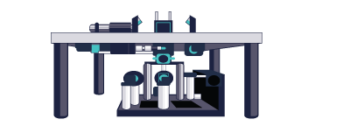Find out the latest in Mid-IR Quantum Cascade Laser applications.
Mid-infrared lasers are providing game-changing solutions to molecular spectroscopy, detection, and imaging in scientific research; the life sciences; defence and security; and process control. This blog details 15 emerging applications utilising tunable Quantum Cascade Lasers from DRS Daylight Solutions in the fields of Materials Science; Bio-Tissue Analysis; Biophysical characterisation and Stand-Off Detection. Written by our DRS Daylight Solutions product Specialist Louis Chawner and our Biophotonics Team Leader Peter Collins.
We will cover the following topics:
- Introduction to the mid-infrared and Quantum Cascade Lasers
- Highlights of 15 published white papers in the following fields:
- Materials Science:- Nanoscopy & Nanostructures; Silicon Photonics; Metasurfaces
- Bio Tissue Analysis – MIR Hyperspectral Imaging in cancer research; Histology & Label free imaging
- Defence & Security:- Stand-off detection and spectroscopy of trace chemicals
Written by Louis Chawner
10-15 minutes Read

Introduction
Mid-infrared lasers are providing game-changing solutions to molecular spectroscopy, detection, and imaging in scientific research; the life sciences; defence and security; and process control. This blog details 15 emerging applications utilising tunable Quantum Cascade Lasers from DRS Daylight Solutions in the fields of Materials Science; Bio-Tissue Analysis and Stand-Off Detection.
What is the mid-infrared?
The mid-IR is classified by the spectral region covering approximately 3 to 50 microns or 3333 to 200 wavenumbers.

Mid-IR absorptions have more identifiable, stronger spectral features than other regions. Another advantage for working in the mid-IR is that it contains two major atmospheric windows (3-5um and 8-12um regions) where there is very weak absorption in the atmosphere.
For more information why don’t you try our other Blog: Why is Mid-IR Light so Important?
Overview of some of the important gases and molecules that have strong spectral signatures in the mid-IR
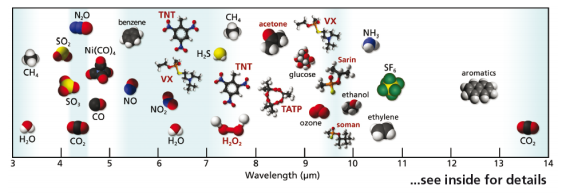
Traditional, mid-IR light has been limited to single wavelengths such as those found with Carbon Dioxide (CO2) Lasers, lead salt lasers which need cryogenic cooling or by nonlinear wavelength conversion for example through OPOs.
In recent years mid-IR tunable laser technology has been transformed by the development of room temperature operation Quantum Cascade Lasers and Interband Cascade Lasers, where the spectral properties can be engineered by the design of the semiconductor layer structure.
What is a Quantum Cascade Laser (QCL)?
Standard diode lasers generate a photon by the process of electron-hole recombination between the conduction and valence bands. The recombination energy or bandgap, of the different material combinations chosen allow light to be generated up to around 2.5 microns.
Quantum cascade lasers (QCLs) are a type of semiconductor laser operating most commonly in the 3.5 – 13.5µm region. A QCL has specially engineered structures which utilises intersubband transitions in a repeated stack of quantum wells.
Unlike the standard laser diode where the electrons and holes are annihilated after recombination, in a QCL the electron responsible for the emission of a photon, can then tunnel into the next quantum well, consequently, several photons can be generated by a single electron which makes them extremely efficient.
The transition from one quantum well to another is the origin of the term “quantum cascade”.
The gain profile of a QCL can be quite broad, and the linewidth of the emission can be very narrow, so when using a QCL in an external cavity, narrow band, widely tunable mid-infrared light is obtained.
Considerable progress has been made in recent years such that mid-infrared lasers are now used in several industries that have stringent requirements.
Here we look at 15 applications for QCLs in the fields of Materials Science; Bio-Tissue Analysis; Biophysical characterisation and Stand-Off Detection.
Contents
Materials Science
- Infrared Nanoscopy of Dirac Plasmons at the Graphene SiO2 Interface
- Heterogeneously Integrated Silicon Photonics for the Mid-Infrared and Spectroscopic Sensing
- Imaging-based molecular barcoding with pixelated dielectric metasurfaces
- Nanoscale Mapping and Spectroscopy of Nonradiative Hyperbolic Modes in Hexagonal Boron Nitride Nanostructures
- High resolution chemical imaging with Photo-Thermal Microscopy (PTIR)
Bio Tissue Analysis – MIR Hyperspectral Imaging
- Label-free, automated classification of microsatellite status in colorectal cancer by infrared imaging
- Concept and setup for intraoperative imaging of tumorous tissue via Attenuated Total Reflection spectroscopy with Quantum Cascade Lasers
- Label-free metabolic imaging by mid-infrared optoacoustic microscopy in living cells
- Microfluidic cantilever detects bacteria and measures their susceptibility to antibiotics in small confined volumes
- Fourier-transform vs. quantum-cascade-laser infrared microscopes for histo-pathology: From lab to hospital
- Webinar Links:
- The Next Generation of Label-Free Imaging
- Label-Free Tissue Classification by Wide-Field, QCL-Based IR-Imaging
Biophysical Characterisation
- Bioreactor monitoring
- Protein Analytics
Defence & Security
- Characterisation and control of tunable quantum cascade laser beam parameters for stand-off spectroscopy
- Ultrasonic photoacoustic spectroscopy of trace hazardous chemicals using quantum cascade lasers
Materials Science
Infrared Nanoscopy of Dirac Plasmons at the Graphene – SiO2 Interface
The high brightness and tunable properties of QCLs allow mid-IR radiation to focus on the apex of a nanoscale tip (AFM Cantilever) which yields 2 orders of magnitude increase of in-plane component resulting in dramatically enhanced nearfield interaction with mid-IR surface phonons of SiO2 substrate.
Broad tuning range allows the user to take data at a high number of spectral points.
This work sets the stage for studying many other properties of Dirac plasmons in graphene, with special interest are effects pertaining to the real-space confinement and propagation of plasmons in nanostructures/ribbons.
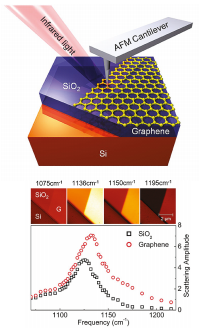
Heterogeneously Integrated Silicon Photonics for the Mid-Infrared and Spectroscopic Sensing
Silicon has become the key material to achieve large scale integration of photonics devices for on-chip optical interconnect and signal processing. For optics, silicon has significant advantages: it offers a very high refractive index and is highly transparent from 1.2 to 8µm. This paper describes a method to integrate a silicon resonator on mid-IR compatible substrates.
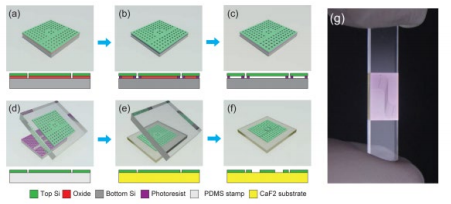
Using a 5.2µm centre wavelength tunable QCL, it was demonstrated, for the first time, on-chip cavity enhanced mid-IR spectroscopic analysis of organic chemicals with a limit of detection of less than 0.1ng.
Imaging-based molecular barcoding with pixelated dielectric metasurfaces
Researchers at EPFL (Lausanne, Switzerland) recently developed a novel nanophotonic sensor array which could someday propane in routine environmental sensing and point-of-care diagnostics.
The new image-based sensor leverages wide-field QCL imaging and functionalized nanofabricated metasurfaces to perform massively parallel sensing of protein and polymer mixture monolayers.
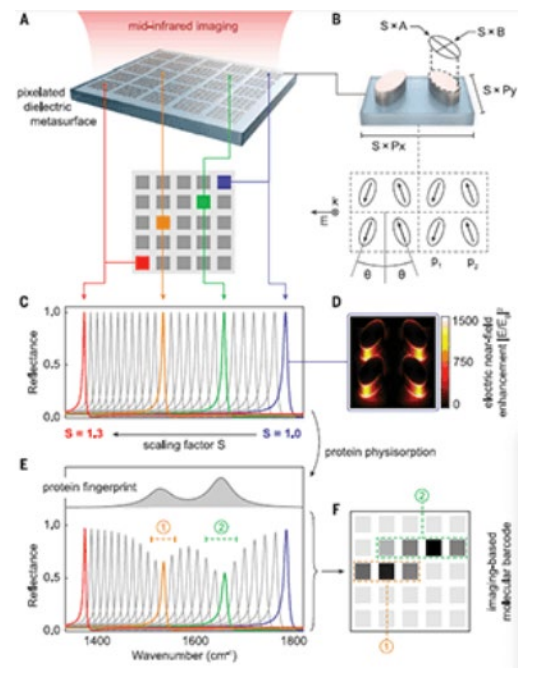
Nanoscale Mapping and Spectroscopy of Nonradiative Hyperbolic Modes in Hexagonal Boron Nitride Nanostructures
The photothermal induced resonance (PTIR) technique probes optical and vibrational resonances overcoming weak far-field emission by leveraging an atomic force microscope (AFM) probe to transduce local sample expansion caused by light absorption.
This paper shows that PTIR enables the direct observation of previously unobserved, dark hyperbolic modes of hBN nanostructures. Leveraging these optical modes and their wide range of angular and radial momenta could provide a new degree of control over the electromagnetic near-field concentration, polarisation in nanophotonic applications.
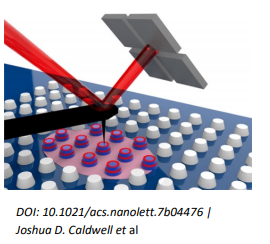
High resolution chemical imaging with Photo-Thermal Microscopy (PTIR)
There are several techniques for chemical imaging of samples. However, most of them are not suited where higher spatial resolution is required. FTIR is limited to 20 microns, and other established techniques are impractical at the nanoscale.
PTIR spectroscopy however has the potential to generate chemical images of samples with spatial resolutions of 1µm, which is below the far-field diffraction limit of a mid-IR beam.
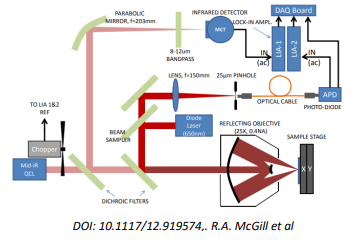
Bio Tissue Analysis – MIR Hyperspectral Imaging
Label-free, automated classification of microsatellite status in colorectal cancer by infrared imaging
This paper presents the feasibility of Quantum Cascade Laser (QCL)-based infrared (IR) imaging as an alternative diagnostic tool for microsatellite instability-high (MSI-H) in colorectal cancer (CRC), which occurs in 15% of early stage CRC and is caused by a deficiency in the mismatch repair system.
Specifically, 100% sensitivity and 93% specificity were achieved based on the independent 30 MSI-H- and 30 microsatellite stable (MSS)-patient validation cohort.
This showed that QCL-based IR imaging is able to distinguish between MSI-H and MSS for sporadic CRC – a question that goes beyond morphological features – based on the use of spatially resolved infrared spectra used as biomolecular fingerprints.
Image shows: Infrared (IR) imaging for microsatellite stable (MSS; light blue) and high microsatellite instability (MSI-H) versus hematoxylin and eosin (H&E) staining of the same tissue section. Shown are example images for three MSS colorectal cancers (CRCs; light blue) and two MSI-H CRCs (orange). The IR images present cancer spectra only; therefore, the background with other tissue types is black.
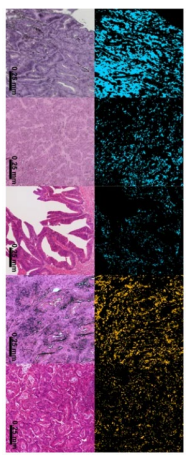
Concept and setup for intraoperative imaging of tumorous tissue via Attenuated Total Reflection spectroscopy with Quantum Cascade Lasers
A major challenge in tumour surgery is the differentiation between normal and malignant tissue. More accurate results and faster measurement times are essential to improving this process. This report details the potential enormous advantages that QCLs can offer in this field.
Hyperspectral imaging in the mid-infrared, especially in the so called “fingerprint region”, allows spatially resolved discrimination between normal and malignant tissue when compared to FTIR, QCLs can be much more suited, and enable far less complexity. They are smaller and lighter and are therefore more suited to the use of hand-held devices, and do not have to heat up like FTIR so can dramatically reduce the time to take data.
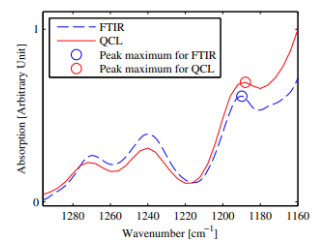
Label-free metabolic imaging by mid-infrared optoacoustic microscopy in living cells:
Mid-Infrared Optoacoustic Microscopy (MiROM), is a technique that can be used for label free and highly sensitive monitoring of carbohydrates, lipids and proteins in cells and tissues.
A broadly tunable pulsed quantum cascade laser (QCL) was used for optoacoustic generation and biomolecular specificity. The laser has a spectral range of 2941-909cm-1 (3.4-11.0 microns) and has a spectral linewidth of <1cm-1 (FWHM).
The laser pulses are focused into the sample and a mid-IR absorption map of the sample was obtained by scanning along the focal plane whilst simultaneously detecting the optoacoustic signal.
Using acoustic detection of optical absorption, MiROM converts midinfrared sensing into a positive-contrast imaging modality with negligible photodamage and high sensitivity.
Vasilis Ntziachristos et al,. https://doi.org/10.1038/s41587-019-0359-9
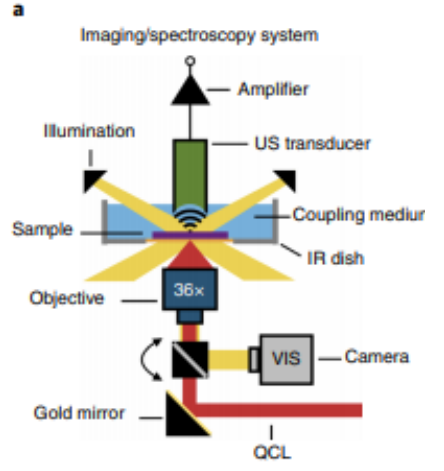
Microfluidic cantilever detects bacteria and measures their susceptibility to antibiotics in small confined volumes
Accurate and high throughput detection is essential in the fight against drug resistant bacteria. A microcantilever with an embedded microfluidic channel can be used to selectively capture bacteria passing through the channel and using a QCL to excite the trapped bacteria provides a mechanical IR spectrum for selective identification.
Using this method and a QCL as the excitation source, more highly reproducible results at better resolution when compared to photo-thermal IR spectroscopy (PTIR) are obtained.
A tunable laser with narrow linewidth means that you achieve many spectral points with high resolution, and a laser with good beam quality is essential for focusing the beam onto the cantilever accurately.
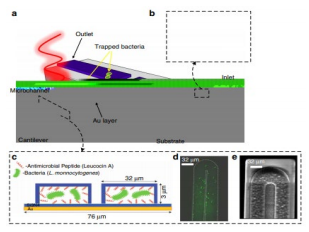
Fourier-transform vs. quantum-cascade-laser infrared microscopes for histo-pathology: From lab to hospital
FTIR microscopy has long been a commonly used technique for histology. However, a new QCL imaging system allows 150 times faster spectral data acquisition compared to FTIR, with zero compromise on the S/N ratio.
The small pixel size of the camera gives very high-resolution images, and the fast acquisition speed means a high sample throughput. This report discusses the advantages of the new technology, and the potential roadmap to bring QCL based IR microscopes into hospitals.
Schematic set-up of FTIR and QCL based IR microscopes Cyril Petibois et al,. | doi.org/10.1016/j.trac.2017.02.007
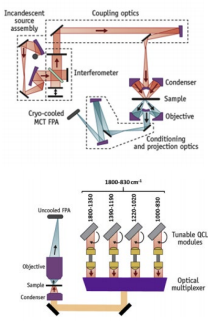
Webinars:
The Next Generation of Label-Free Imaging
Label-Free Tissue Classification by Wide-Field, QCL-Based IR-Imaging
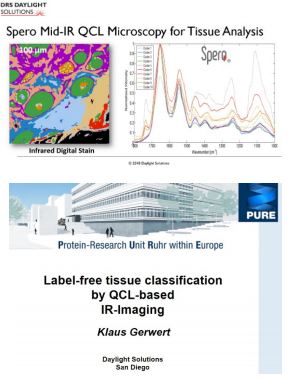
Defence & Security
Characterisation and control of tunable quantum cascade laser beam parameters for stand-off spectroscopy
Laser requirements for stand-off detection are more stringent than for other applications, therefore, it is important for commercial “turn-key” QCL systems that are to be used for stand-off spectroscopy to have careful calibration and monitoring of the laser parameters.
Experimental set-up for a wavelength measurement
Several methods for calibration of wavelength, power, beam size and profile are presented.
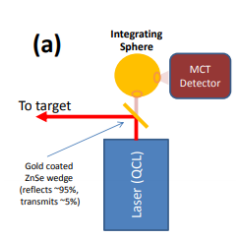
Ultrasonic photoacoustic spectroscopy of trace hazardous chemicals using quantum cascade laser
An ultrasonic sensor based on open-cell photoacoustic spectroscopy for the detection of explosive agents in traces.
A tunable mid-IR QCL in the wavelength range 7.0 – 8.8um lying in the molecular fingerprint region was used as the optical source.
Samples of Pentaerylthirol Tetranitrate (PETN), Tetranitrotriazacyclohexane (RDX), Dinitrotoluene, p-Nitrobenzoic acid and other chemicals like Ibuprofen having a quantity of ~1.0mg were detected in both a photoacoustic cell.
The explosive traces were swiped using paper from contaminated surfaces and detected.
D. Kumar, et al., Optics Communications (2016), doi.org/10.1016/j.optcom.2016.07.017
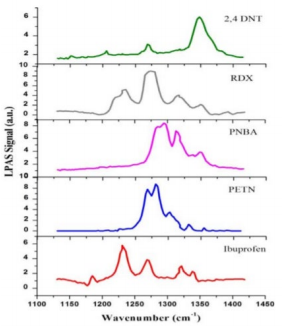
Summary
Thanks for taking the time to read this months blog. The research shows that there are many exciting applications that QCLs can service. Lots of credit has to go to the fantastic research done by many groups across the world.
QCLs are moving into applications currently served by older technologies and are offering some significant advantages. The small size and low power consumption makes them suitable for field deployment, and the fact that they need no cryogenic cooling simplifies experimental setup. Their high brightness and narrow linewidth mean that you can achieve measurements that are highly selective and with very good signal to noise. All in all, the future of QCLs looks very bright.
Want to discuss how we can help in your application?
Contact us here:
Other Blogs/Articles that may be of interest:











